A DDA nurse is planning care for a client who is in labor and is to have an amniotomy. Which of the following assessments should the nurse identify as the priority?
O2 saturation
Temperature
Blood pressure
Urinary output
The Correct Answer is B
Choice A Reason:
Oxygen Saturation: While oxygen saturation is important, it is not the highest priority assessment related to amniotomy. Monitoring oxygen levels is crucial during labor, but other factors take precedence
Choice B Reason:
Temperature: Correct. The nurse should prioritize monitoring the client’s temperature following an amniotomy. If the patient’s temperature is 38°C (100.4°F) or higher, the nurse needs to notify the primary care physician promptly. Elevated temperature can indicate infection, which is a significant concern after the rupture of membranes. The nurse should also assess for other signs of infection, such as chills, uterine tenderness on palpation, foul-smelling vaginal drainage, and fetal tachycardia.
Choice C Reason:
Blood pressure is incorrect. Blood pressure is an essential parameter to monitor during labor, but it may not be the immediate priority when planning an amniotomy. Oxygen saturation takes precedence as it provides more direct information about the oxygenation status of both the mother and the fetus.
Choice D Reason:
Urinary output is incorrect. Urinary output is a vital sign to monitor, but it may not be the immediate priority when preparing for an amniotomy. O2 saturation is more directly relevant to the potential effects on the fetus during this intervention.
Nursing Test Bank
Naxlex Comprehensive Predictor Exams
Related Questions
Correct Answer is B
Explanation
A. Shoulder presentation is not typically described using the terms RSA. Shoulder presentation would be noted differently, and it is uncommon.
B. Breech presentation involves the presentation of the fetus with the buttocks or feet first. RSA indicates the specific position of the sacrum in relation to the mother's right side.

C. Vertex presentation refers to the head-first position, and it is not described using the terms RSA.
D. Mentum presentation is not a standard term used to describe fetal presentation. Mentum typically refers to the chin, and fetal presentations are commonly described in terms of the presenting part (e.g., vertex, breech).
Correct Answer is A
Explanation
The correct answer is A. Slow-paced breathing
A. Slow-paced breathing is a nonpharmacological comfort measure that involves taking slow, deep breaths to promote relaxation and reduce anxiety. It can be an effective technique for managing pain during contractions.
B. Biofeedback involves the use of electronic monitoring to provide feedback about physiological processes, and it is not typically used as a primary nonpharmacological comfort measure for labor pain.
C. Self-hypnosis is a relaxation technique that involves guided imagery and focused concentration to promote relaxation and reduce pain. However, it may require some previous knowledge or practice, and in the context of this scenario, slow-paced breathing may be a more immediate and accessible option.
D. Acupuncture involves the insertion of needles into specific points on the body to stimulate energy flow. While acupuncture can be effective for pain management, it may not be readily available in all labor settings, and slow-paced breathing is a more universally applicable option.
Whether you are a student looking to ace your exams or a practicing nurse seeking to enhance your expertise , our nursing education contents will empower you with the confidence and competence to make a difference in the lives of patients and become a respected leader in the healthcare field.
Visit Naxlex, invest in your future and unlock endless possibilities with our unparalleled nursing education contents today
Report Wrong Answer on the Current Question
Do you disagree with the answer? If yes, what is your expected answer? Explain.
Kindly be descriptive with the issue you are facing.
